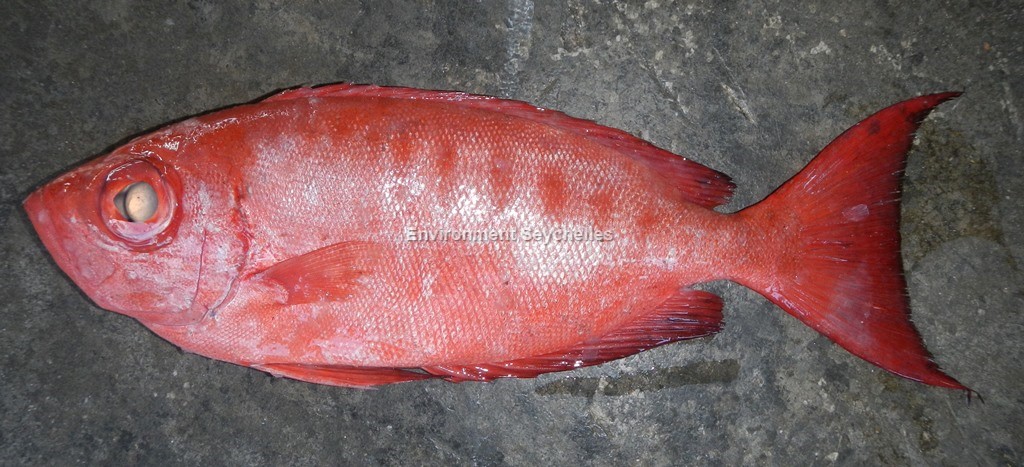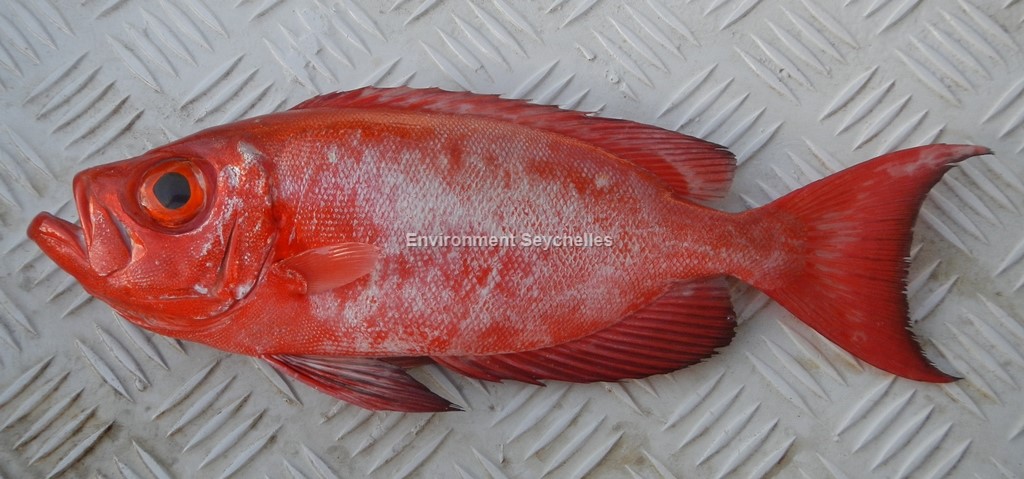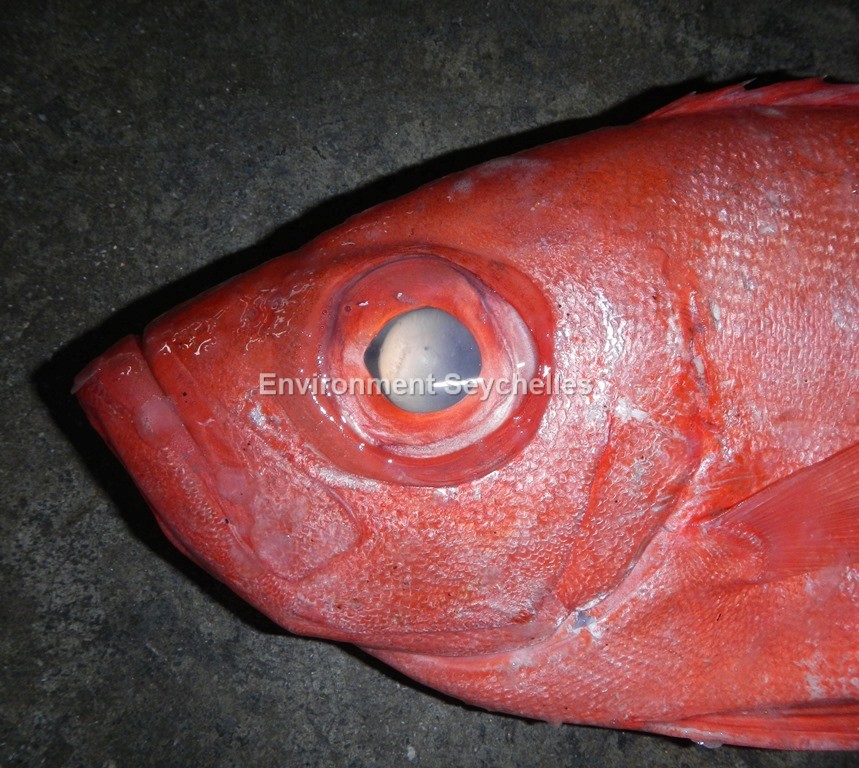Description:
Dorsal spines: 10; Dorsal rays: 13-15; Anal spines: 3; Anal rays: 13-16.
Body moderately deep, ovate and laterally compressed. Eye large. Mouth oblique tip of lower jaw protrudes when mouth closed. Jaws with small teeth. Posterior of maxilla reaches below anterior half of eye. Poorly developed preopercular spine, inconspicuous to non-existent in adults. Scales covering most of head and body onto base of caudal fin. Soft portion of dorsal fin taller than spinous portion and angular posteriorly. Pectoral fins shorter than pelvic spine. Pelvic fins long, reaching posterior to spinous portion of anal fin. Caudal fin truncate in juveniles; concave to lunate in adults.
Colour. Body, head, and iris of eye red. Capable of changing to silvery with red bars or large spots in a matter of seconds. Row of small dark spots sometimes evident along lateral line. Median fins dusky, without distinct dark spots. Pelvic fins dusky usually with black spot at base of first three rays.
Size:
Maturity: Lm unknown. Range unknown. Max Length: 45cm TL. Commonly to 40cm TL.
Habitat and Ecology:
Inhabits coral reefs and rocky bottoms (depth 3-250m, typically 30-50m). Prefers outer reef slopes to more sheltered environments. Usually inactive by day, seen singly under ledges or near coral heads or in small aggregations schooling above the reef. Feeds on small fish, crustaceans, and other small invertebrates
Fishery Status:
This species is not protected or subject to fishery regulations. It is caught in the fish trap fishery and by handline, it is a periodic but not common or abundant component of the catch.
Notes:
References:
Carpenter, K.E. et al 2016. Priacanthus hamrur. The IUCN Red List 2016: e.T46087863A46664864. http://dx.doi.org/10.2305/IUCN.UK.2016-3.RLTS.T46087863A46664864.en. (18/08/19).
Froese, R. & D. Pauly. Eds. 2019. FishBase. https://www.fishbase.se/summary/Priacanthus-hamrur (18/08/19).
Heemstra P & Heemstra, E. (2004). Coastal Fishes of Southern Africa. NISC SAIAB. ISBN: 1-920033-01-7.
Starnes, W.C., 1988. Revision, phylogeny and biogeographic comments on the circumtropical marine percoid fish family Priacanthidae. Bull. Mar. Sci. 43(2):117-203.
Citation:




pin up casino https://azerbaijancuisine.com/# pin up casino azerbaycan
pin-up oyunu
pin up 360: pin up 306 – pin up apk yukle
mexican mail order pharmacies: mexican pharmacy – medicine in mexico pharmacies
https://northern-doctors.org/# purple pharmacy mexico price list
mexican border pharmacies shipping to usa: mexican northern doctors – buying prescription drugs in mexico online
mexican drugstore online mexican northern doctors mexico drug stores pharmacies
п»їbest mexican online pharmacies: Mexico pharmacy that ship to usa – mexican drugstore online
http://northern-doctors.org/# mexican pharmaceuticals online
pharmacies in mexico that ship to usa: northern doctors – п»їbest mexican online pharmacies
mexican online pharmacies prescription drugs Mexico pharmacy that ship to usa buying prescription drugs in mexico online
Very well written! The points discussed are highly relevant. For further exploration, I recommend visiting: LEARN MORE. Keen to hear everyone’s opinions!
mexico drug stores pharmacies mexican northern doctors mexican mail order pharmacies
mexican drugstore online buying prescription drugs in mexico best online pharmacies in mexico
buying prescription drugs in mexico
https://cmqpharma.com/# mexican pharmaceuticals online
mexican drugstore online
indian pharmacies safe: indian pharmacy online – cheapest online pharmacy india
canadian pharmacy: canadian world pharmacy – cheapest pharmacy canada
buy prescription drugs from india indian pharmacies safe Online medicine order
mexican border pharmacies shipping to usa: mexico pharmacies prescription drugs – mexico pharmacy
https://foruspharma.com/# best online pharmacies in mexico
pharmacies in mexico that ship to usa: mexican pharmacy – pharmacies in mexico that ship to usa
best canadian pharmacy: canadian pharmacy – onlinepharmaciescanada com
reputable mexican pharmacies online purple pharmacy mexico price list п»їbest mexican online pharmacies
indian pharmacy: reputable indian pharmacies – buy prescription drugs from india
buy medicines online in india: indianpharmacy com – indianpharmacy com
best india pharmacy Online medicine order india online pharmacy
pharmacy website india: online shopping pharmacy india – п»їlegitimate online pharmacies india
pharmacy in canada: my canadian pharmacy – canadian pharmacy world
indian pharmacies safe: reputable indian pharmacies – indianpharmacy com
http://foruspharma.com/# pharmacies in mexico that ship to usa
http://amoxildelivery.pro/# amoxicillin no prescipion
https://ciprodelivery.pro/# antibiotics cipro
http://amoxildelivery.pro/# buy amoxicillin from canada
ciprofloxacin 500 mg tablet price: where can i buy cipro online – buy cipro no rx
http://paxloviddelivery.pro/# paxlovid pharmacy
http://paxloviddelivery.pro/# buy paxlovid online
amoxicillin script: amoxicillin online no prescription – amoxicillin without rx
https://ciprodelivery.pro/# buy cipro cheap
https://amoxildelivery.pro/# amoxicillin 500mg prescription
https://paxloviddelivery.pro/# paxlovid pharmacy
https://paxloviddelivery.pro/# Paxlovid over the counter
amoxicillin 500mg cost: amoxicillin 200 mg tablet – amoxicillin capsules 250mg